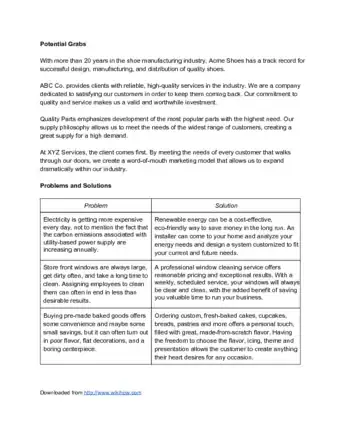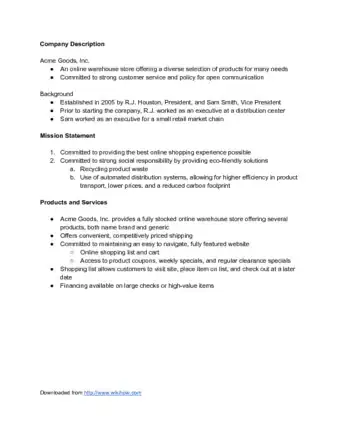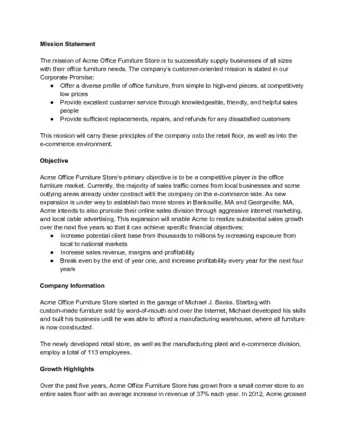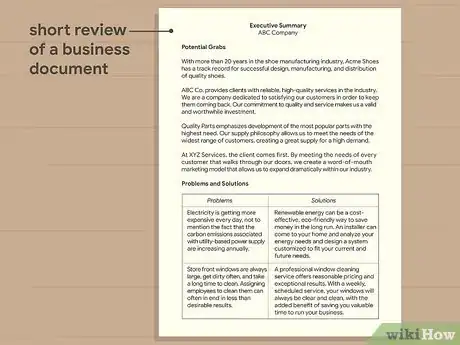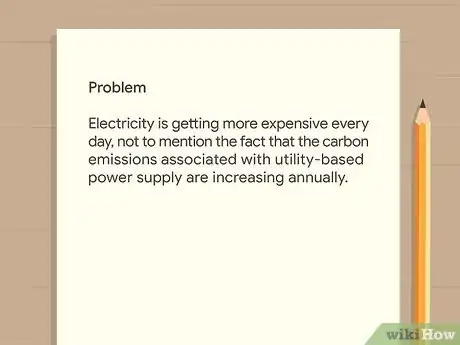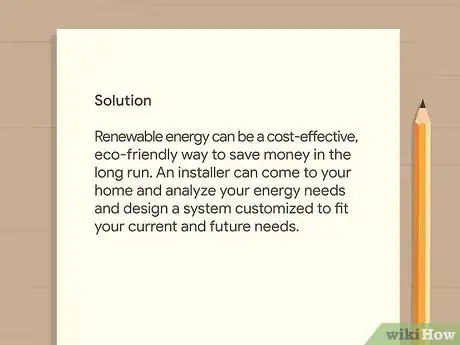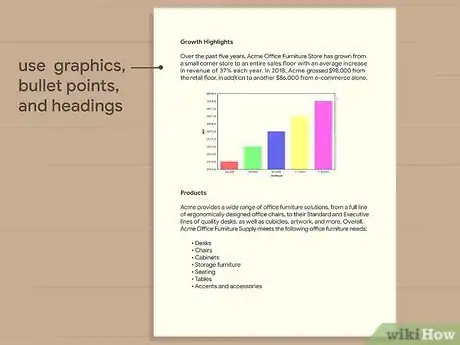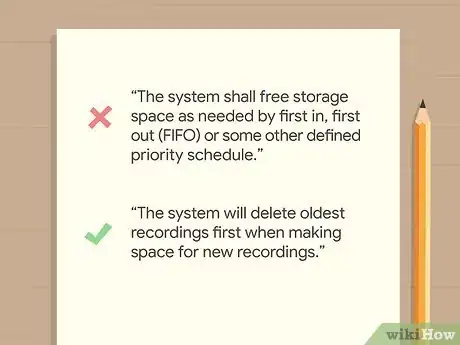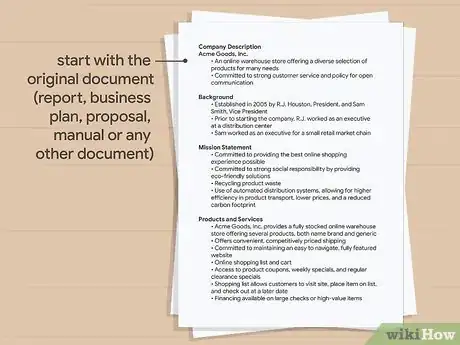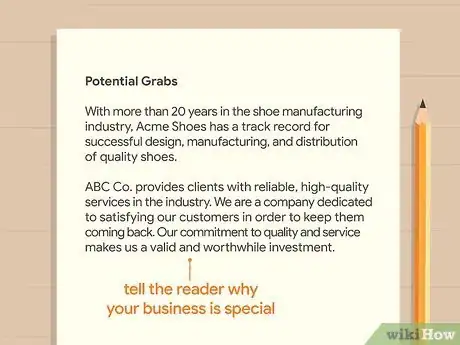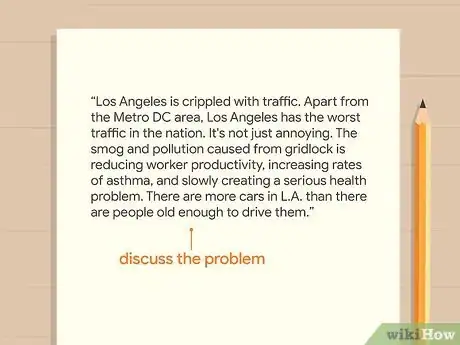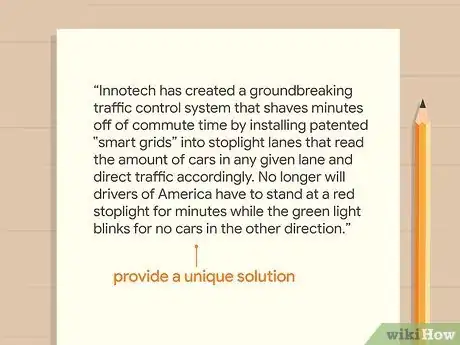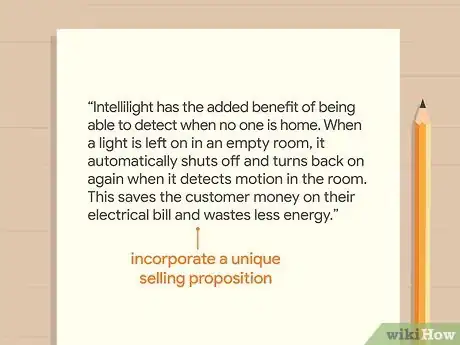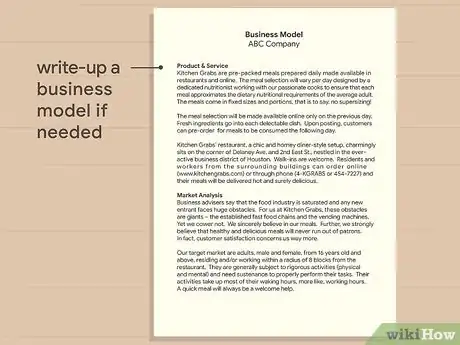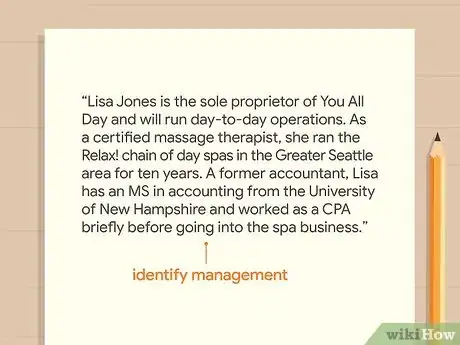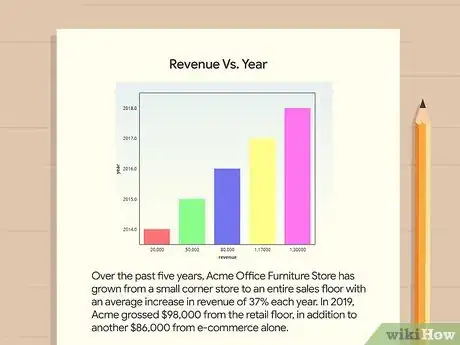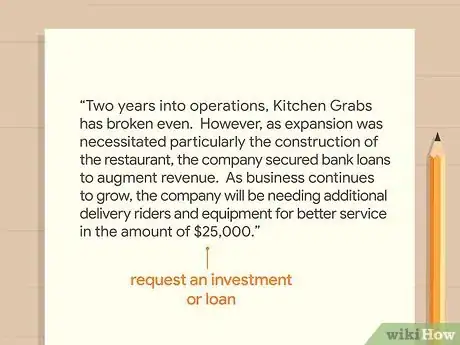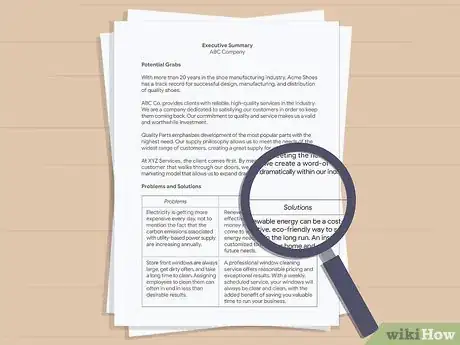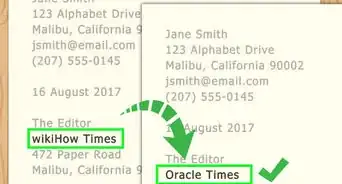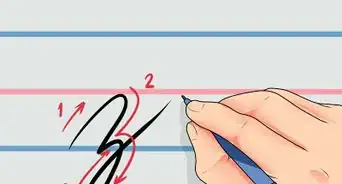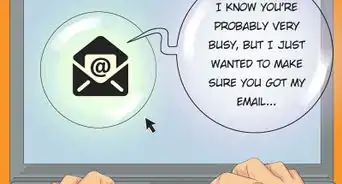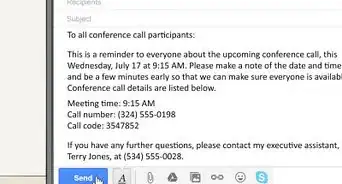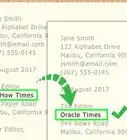wikiHow is a “wiki,” similar to Wikipedia, which means that many of our articles are co-written by multiple authors. To create this article, 41 people, some anonymous, worked to edit and improve it over time.
This article has been viewed 2,018,406 times.
Learn more...
The executive summary is the most important part of a business document. It is the first (and sometimes the only) thing others will read and the last thing you should write. It is simply a brief review of the document, given so the busy people who will read your document know at a glance how much to read and what actions will probably be needed.
Steps
Summary Help and Sample Summary
The Basics
-
1Understand that an executive summary is a short review of a business document. "Short" and "review" are key words here. The executive summary is not going to be comprehensive in any way, nor will it be a substitute for the original document. An executive summary should never be longer than 10% of the original document.[1] Shoot to have it somewhere between 5% and 10%.
Tip: An executive summary is different from an abstract. An abstract gives the reader overview and orientation, while an executive summary gives the reader more of a summary. Abstracts are more commonly written in academia, while executive summaries are used more for business purposes.
-
2Make sure it adheres to certain stylistic and structural guidelines. Most authoritative sources who write executive summaries agree that certain stylistic and structural guidelines should apply. These include:[2]
- Paragraphs should be short and concise.
- Executive summaries should make sense even if you haven't read the original report.
- Executive summaries should be written in language that is appropriate for the target audience.
Advertisement -
3Define the problem. An executive summary needs to clearly define a problem, whether it's supply-chain management or marketing campaigns overseas. Executive summaries, especially, need clear definitions of problems because the documents that they are based on, Requests For Proposals (RFP), are often written by technical people with a poor grasp of conceptual issues. Make sure the problem is defined in clear, understandable terms.[3]
-
4Provide a solution. A problem is always in need of a solution. In order to deliver a claim statement of purpose (and a reason to fund the venture), you need to present your solution so that it effectively tackles the problem. If your problem isn't clearly written, your solution is less likely to make sense.[4]
-
5Use graphics, bullet points, and headings if the document is easier to skim that way. An executive summary is not an essay; it doesn't need to be long blocks of text. If they enhance understanding or make the summary more skimmable, it's okay to use:[5]
- Graphics. A well-placed graphic illustrating the precise nature of the client's problem could drive home the point of the summary. Stimulating the visual sense is often just as effective as their analytical sense.
- Bullets. Long lists of information can be broken down into more digestible bullets.
- Headings. Organize the themes of the summary, if necessary, by heading. This will help orient the reader as they dive into the summary.[6]
-
6Keep the writing fresh and jargon-free. Jargon is the enemy of understanding. It just so happens to be popular in the business world. Words like "interface," "leverage," "core competency," and "burning platform" are all words that you should strive to avoid. They obscure real meaning and can make the summary sound vague and devoid of specifics.[7]
The Specifics
-
1Start with the original document. Since the executive summary is a summary of another document, you'll need to be pretty familiar with the original document in order to condense it down to a manageable and informative version. Whether that original document is a report, business plan, proposal, manual or different document, review it, looking for its main ideas.[8]
-
2Write a brief review. What is the purpose of the company sponsoring the document, or of the original document itself? What is its scope?[9]
- Example: "Women World Wide is a not for profit organization that seeks to connect women all around the world with effective solutions to domestic violence, as well as offering a network of support for those suffering from domestic violence. While operating from its headquarters in Alberta, Canada, it has received referrals from women in 170 countries across the globe."
-
3Make the "grab" shine. This section is probably the most important part of your entire executive summary. In two or three sentences you should tell the reader why your business is special. Why does it deserve the scrutiny, business, or partnership of the people reading the summary?[10]
- Maybe you have Michael Jordan as a customer and he has endorsed your product on Twitter for free. Maybe you just signed a partnership agreement with Google. Maybe you were just awarded a patent, or maybe you just made your first big sale.
Tip: Sometimes just a simple quote or testimonial is enough. The key is to grab the attention of your audience, make the business appear as reputable as possible, and draw the reader in to the rest of the document.
-
4Define the big problem. The first real ingredient of an executive summary is a discussion of a problem, so explain the problem that your products/services address.[11] Make sure the problem is defined as clearly as possible. An ill-defined problem doesn't sound convincing, and won't set up your solution to be as impactful as it could be.
- Example: "Los Angeles is crippled with traffic. Apart from the Metro DC area, Los Angeles has the worst traffic in the nation. It's not just annoying. The smog and pollution caused from gridlock is reducing worker productivity, increasing rates of asthma, and slowly creating a serious health problem. There are more cars in L.A. than there are people old enough to drive them."
-
5Deliver your unique solution. The big problem is the easy part. Now you have to convince the reader that you have come up with a unique solution for the big problem. If you deliver these two ingredients, you'll have the makings of a great idea.[12]
- Example: "Innotech has created a groundbreaking traffic control system that shaves minutes off of commute time by installing patented "smart grids" into stoplight lanes that read the amount of cars in any given lane and direct traffic accordingly. No longer will drivers of America have to stand at a red stoplight for minutes while the green light blinks for no cars in the other direction."
-
6Talk about market potential. Elaborate on the big problem by providing stats for your industry. Be careful not to pretend that you have a larger market than you do! The fact that the medical device industry is $100 billion annually means nothing because your new medical device will only serve a small segment of the industry. Break it down to a realistic market potential.
-
7Incorporate your unique selling proposition. This is where you elaborate on your unique solution. What specifically gives your product or service an advantage over the competition? Maybe your home health care service actually sends doctors to the home instead of just nurse practitioners, or maybe you guarantee same day visits so that you don't have to schedule ahead of time. Point out why you are special.
- Example: "Intellilight has the added benefit of being able to detect when no one is home. When a light is left on in an empty room, it automatically shuts off and turns back on again when it detects motion in the room. This saves the customer money on their electrical bill and wastes less energy."
-
8Talk about your business model, if necessary. Some executive summaries will not need a business model. (Nonprofits, not for profits, and NGOs probably won't have a business plan.) But if yours does, your business model needs to be clear and easy to follow. Essentially, you are answering the question, "How will you get people to take dollars out of their wallet and give them to you?" Keep the model simple, especially in the executive summary. A quick summary is all that is needed.
-
9Discuss your management team, if necessary. Depending on what industry you are in, this can be one of the most important parts of your executive summary. Your investors or bankers are putting trust in the team, not the idea. Ideas are easy to come by, but executing on those ideas can only be accomplished with a strong team. Quickly show why your team has the experience and knowledge to execute your business plan.
-
10Provide financial projections to support your claims. Based on your market, your business model, and your historical performance, you need to develop a bottom-up financial forecast. The point of your projections is simply to demonstrate your competence, and your ability to build financial projections based on a sound set of assumptions.
- If your plan is for a group of investors, don't spend too much time on this section because they know that you have no idea how much money you might make. Investors typically won't make a go/no-go decision based on your financial projections. They will essentially make their own financial projections.
-
11Ease in to your request. Now it's time to request either an investment or loan, depending on the purpose of the executive summary. You should restate why your company provides value. Remind the reader of the big pain that you are solving and your market potential. Finally reemphasize your team and its ability to get the job done. Ask for the dollar amount needed to reach the next major milestone for your business. Don't disclose how much equity you are willing to give up or what interest rate you are willing to pay. This should be done later through face-to-face negotiation.
-
12Reread your summary. When you have written the basics, reread it carefully. You should proofread the summary with extra care. While you are rereading, also consider your audience for the document. Make sure any new references are explained and that the language will be clear to someone who is new to this topic. Rewrite as necessary.[13]
- Have a pair of fresh eyes reread your executive summary, paying special attention to:
- Clarity. Are the words clear, the ideas clearer, and the summary devoid of jargon?
- Errors. Grammatical, punctuation, and spelling errors may abound. Having someone fact-check the figures and statistics might be a good ideal as well.
- Forcefulness. Do the ideas translate into a stirring pitch? Where does the pitch fall flat, if at all?
- Coherence. What parts don't fit together? What parts do?
- Have a pair of fresh eyes reread your executive summary, paying special attention to:
Community Q&A
-
QuestionDo I include references in an executive summary?
 Community AnswerNot normally. References should be in the main body of a report or included in the bibliography or appendices.
Community AnswerNot normally. References should be in the main body of a report or included in the bibliography or appendices. -
QuestionNormally how many typed pages is a summary?
 Community AnswerIt could range anywhere between 1 to 10 pages. It shouldn't be more than 10% of your entire document or report.
Community AnswerIt could range anywhere between 1 to 10 pages. It shouldn't be more than 10% of your entire document or report. -
QuestionHow do I end an executive summary?
 Community AnswerThere's no specific way to end it. It's very straightforward and minimalistic.
Community AnswerThere's no specific way to end it. It's very straightforward and minimalistic.
References
- ↑ https://libguides.usc.edu/writingguide/executivesummary
- ↑ https://libguides.usc.edu/writingguide/executivesummary
- ↑ https://rasmussen.libanswers.com/faq/171743
- ↑ https://rasmussen.libanswers.com/faq/171743
- ↑ https://business.fiu.edu/pdf/Tip-Executive-Summary-Breakdown.pdf
- ↑ https://writingcenter.ashford.edu/writing-executive-summary
- ↑ https://rasmussen.libanswers.com/faq/171743
- ↑ https://libguides.usc.edu/writingguide/executivesummary
- ↑ https://writingcenter.uagc.edu/writing-executive-summary
- ↑ https://business.fiu.edu/pdf/Tip-Executive-Summary-Breakdown.pdf
- ↑ https://business.fiu.edu/pdf/Tip-Executive-Summary-Breakdown.pdf
- ↑ https://business.fiu.edu/pdf/Tip-Executive-Summary-Breakdown.pdf
- ↑ https://writingcenter.uagc.edu/writing-executive-summary
- ↑ https://www.businesswritingblog.com/business_writing/2013/05/write-better-executive-summaries.html
About This Article
To write an executive summary, start by reading through the original document thoroughly. An executive summary is a discussion of a problem, so define the problem presented in the original document as simply and clearly as possible. The summary should then detail a solution that effectively tackles the problem. Use graphics, bullet points, and headings to break up the text so the summary is easier to skim through, and finish with a solid argument for why your company needs an investment or a loan to solve the central problem. To learn more about how to include business propositions and your market potential, continue reading the article!
